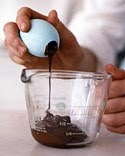Chocolate Eggs
from Martha Stewart
All right, I know what you're thinking: this is really more of a project than a recipe, but if you can eat it, then in my book it's a recipe. I have been dying to try these for a few years, and I think this spring is the year;)
Martha used Valrhona dark chocolate in this recipe because it is relatively easy to temper; the temperatures that are listed apply specifically to this brand.
Chocolate Egg How-To
1. Using a pin, poke a hole in the bottom of a large raw egg; insert the tip of a utility knife, and turn to open the hole slightly. Using a rotary drill fitted with a 3/8-inch bit, carefully widen the hole to at least 1/2 inch in diameter.
2. Insert pin into the hole to pierce and "stir" the yolk. Hold the egg, hole down, over a bowl, and blow air into the hole with a rubber ear syringe (the air will displace and expel the egg). Rinse out egg. Repeat to make 12 blown eggs (you may want to make extras in case some break).
3. Sterilize eggs: Submerge them in a pot of cold water with 1 tablespoon white vinegar; bring to a boil, then simmer, skimming foam from surface, 10 minutes. Let drain on a pin board. If not dyeing eggs, let dry completely on pin board, 2 to 3 days (check insides for moisture).
4. If dyeing eggs: Mix 4 tablespoons vinegar and 12 drops of blue food coloring with 2 cups boiling-hot water in a heatproof glass or enamel bowl. Fill a separate cup with white vinegar. Using a plastic spoon, dip eggs in vinegar, then into the dye, 2 to 3 minutes. Pat eggs with paper towels to eliminate streaks. (If dye begins to cool while you're working, make a new batch.) Let the eggs dry as described above.
5. Using an offset serrated knife, very finely chop 3 pounds of chocolate. Reserve 1 cup chocolate; using a bench scraper, transfer remaining chocolate to a large heatproof bowl.
6. Temper chocolate: Set bowl over a pan of simmering water. Melt chocolate, stirring occasionally, until a chocolate thermometer registers 131 degrees. (Note: Many brands of dark chocolate should not be heated to more than 118 degrees.) Remove from heat; stir in reserved cup chocolate until completely melted. Pour 2/3 of the melted chocolate onto a clean smooth work surface (such as marble or stainless steel). Spread thinly with an offset spatula. Then gather together chocolate, and take temperature. Continue spreading and gathering chocolate until it cools to 82 degrees to 84 degrees.
7. Scrape chocolate back into bowl with remaining chocolate. Stir until it cools to 82 degrees to 84 degrees. Set bowl over a pan of warm water, and reheat to 88 degrees. To check consistency, dip a spoon in chocolate and remove; chocolate should set in about 2 minutes, turning shiny and hard. Note: This temperature must be maintained as you fill the eggs; keep a thermometer in the chocolate, and check frequently. Rest the bowl on a heating pad wrapped in a towel, or set bowl over the pan of warm (not hot) water.
8. Place eggshells in an egg carton. Place a disposable pastry bag in a tall glass, and fold top down. Fill bag with chocolate; cut tip to create a 1/4-inch opening.
9. For solid chocolate eggs: Insert tip of bag into each egg, and fill with chocolate (about 1/4 cup per egg; fill a new bag with chocolate as needed). Let set completely, about 4 hours.
10. Alternatively, fill eggs with ganache: Fill all eggs with chocolate, then let stand 5 minutes instead of letting chocolate set. Pour chocolate out of eggs into a glass measuring cup, tapping your hand against cup to let most of the chocolate drain out (do not add to tempered chocolate). Let chocolate "shells" set completely.
11. Fill a disposable pastry bag with ganache (recipe follows); cut tip to create a 1/4-inch opening. Insert tip into egg; fill with ganache. Tap egg gently, hole up, on a folded kitchen towel to eliminate air pockets; fill to top. Continue with remaining eggs. Refrigerate until set, about 4 hours. Ganache-filled eggs can be refrigerated up to 1 week; solid eggs can be stored in a cool, dry place until ready to serve.
To Make Ganache
For semisweet ganache, use 2 cups heavy cream and 1 pound semisweet chocolate. For milk-chocolate or white-chocolate ganache, use 1 1/4 cups heavy cream and 1 1/4 pounds milk or white chocolate. Bring cream just to a boil, then pour over finely chopped chocolate into a medium bowl. Let stand 5 minutes; stir until smooth. Press plastic wrap directly onto surface; let stand, stirring occasionally, until cool enough to pipe (no warmer than 80 degrees), 1 to 2 hours.
Note: The steps here are for tempering chocolate by hand. If you work with chocolate frequently, investing in a tempering machine will save time and make cleanup easier -- and the chocolate will be perfectly creamy, smooth, and shiny. Every brand of chocolate requires different tempering temperatures; see package instructions. For Valrhona, the following temperatures apply: milk chocolate, heat to 118 degrees, cool to 81 degrees to 82 degrees, then warm to 84 degrees to 86 degrees; white chocolate, heat to 118 degrees, cool to 79 degrees to 81 degrees, then warm to 82 degrees to 84 degrees.










































2 comments:
I've got this one on my list too. Only I cheated and used dark chocolate candy melts from Michaels. I don't think it's as yummy but still really cool. Enjoy!
i decided to make these this year as well. i am in the process of blowing and cleaning the eggs. hopefully this weekend they will be filled with giandua...yum!
Post a Comment